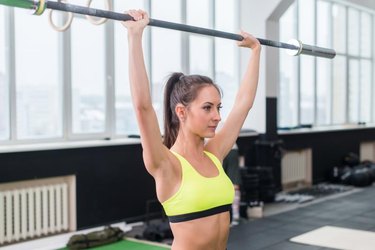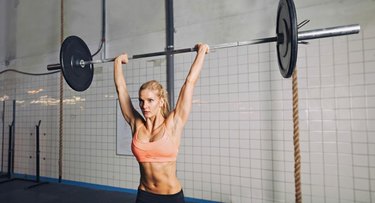
The military press, also known as the strict press, was once hailed as the best measure of pure strength in an article in the Journal of Sport History. While that is arguable, the military press has undoubtedly stood the test of time. It was one of the first weightlifting lifts included in the Olympics in 1924, and tests the strength of your shoulders, triceps and part of your chest.
Only a few muscles do the majority of the work in a military press, but most your muscles should be contributing in some way. The military press differs from many exercises because you don't have any support from a bench or machine. It's important to be rigid in your legs and core because that creates a base from which you can press.
Video of the Day
Video of the Day
How to Do It
The exercise starts with the barbell resting on your shoulders or upper chest. Place your hands slightly wider than shoulder-width apart. You then press the barbell up and slightly back, moving it straight up over your head while keeping your knees completely straight. After your press the barbell up, you slowly lower back down to the starting position.
Read More: Military Press vs. Behind-the-Neck Press
Muscles Used in the Press
Behind the scenes, many muscles work to make the press happen. The most obvious are the muscles of the shoulder, part of the chest and the triceps. Perhaps not as obvious are the muscles of the core that are keeping you upright while you press.
Deltoids
The primary muscles that you use to press up are the deltoids. There are three parts to the deltoids: anterior (front), medial (middle) and posterior (back). In the military press you use the anterior and medial deltoid to press straight up. The posterior deltoid only works when you're pulling something towards you or spreading your arms apart, which doesn't happen in the military press.
Triceps
The triceps are the muscles on the bottom of your arm, opposite of the biceps. These arm muscles work to extend your elbows, which is important throughout the military press. A 2013 study in the Journal of Strength and Conditioning Research shows that the standing barbell shoulder press uses the triceps more than using dumbbells or pressing from a seated position. Therefore, the military press is the best option for triceps development among shoulder pressing variations.
Chest
The upper part of your chest is also somewhat active in the overhead press. The pectoralis major, the chest muscle, is split into two parts. The lower portion is more active in something like the bench press but the upper region can help you press something overhead. The upper region is called the clavicular head.
Read More: Incline Press Vs. Military Press

Abdominals
The less obvious muscles active in the overhead press are the core muscles. The barbell is about six feet long and holds weights on either side. If you lean too far in one direction it feels like you are going to tip over. Your obliques have to work very hard to keep you from leaning too far to the left or right.
In the military press you'll feel compelled to lean backwards as you press up. This is natural because your body weight is shifting away from the heavy object in your hands to maintain balance. Unfortunately, you can also end up with a curve in your lower back from leaning too far back. Once again, your abs come to the rescue. The rectus abdominis, or "six-pack muscle," connects your ribs and your pelvis and can resist the leaning back motion that causes a large curve in your lower back while pressing.